By Luisa LaFleur, The Children’s Book Review
Published: November 22, 2012
There have been many times when my kids have stumped me with questions about their surroundings or about how things work or about why things happen. They would ask simple questions like “why do planes fly?” or “why do you have to go to work?” that I had no idea how to answer without displaying my ignorance (about planes) or my frustration (about work). I wish that I had seen any one of the following books at those times; they would have saved me lots stress and my kids would have gotten some answers.
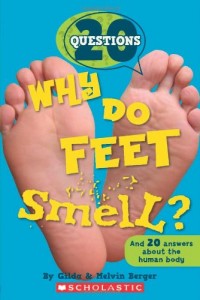 Why Do Feet Smell?
Why Do Feet Smell?
By Gilda and Melvin Berger
Reading level: Ages 7-10
Paperback: 48 pages
Publisher: Scholastic
What to expect: Answers to intriguing questions; physiological concepts; age-appropriate information
Why Do Feet Smell? tackles some of the most common questions about our bodies—things that we have all experienced but don’t always know how to explain. It includes the answers to twenty questions such as: what’s a burp? where do freckles come from? what’s that stuff in your ears? and of course, why do feet smell? This handy paperback includes a glossary of reference terms and an index for finding information at a glance. Because of the simple explanations and colorful photographs this book is sure to be enjoyed by various ages–from the littlest pre-readers to more curious independent readers.
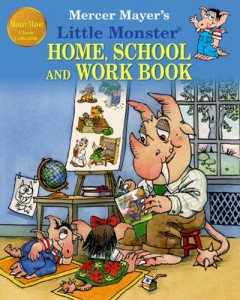 Little Monster Home, School and Work Book
Little Monster Home, School and Work Book
By Mercer Mayer
Reading level: Ages 0-5
Hardcover: 92 pages
Publisher: FastPencil PREMIERE
What to expect: A guide to what goes on at home, at school and at work.
In this latest installment of the beloved Little Monster series, author Mercer Mayer sets about explaining what goes on at home, at school and at work. The guide is split into three chapters and is quite comprehensive. In the home section, we encounter Little Monster and his family and get detailed explanations of what they do in each room in their home. The chapter also tells us what happens at Little Monster’s house during different seasons—in the spring, they clean; in the summer they harvest. The chapter on school sets out Little Monster’s daily routine—from waking in the morning and getting ready to arriving at school and how to behave during the day. The chapter on work illustrates different places to work—such as at the airport or in a newspaper plant—and the many varied professions that come together in those settings. The illustrations really get to the heart of the matter and provide further insight to the clever, age-appropriate language.
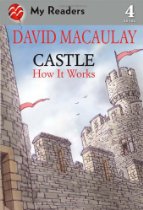 Castle: How it Works
Castle: How it Works
Jet Plane: How it Works
By David Macaulay
Reading level: 7-8
Paperback
Publisher: Roaring Books Press (David Macaulay Studio)
What to expect: Illustrated explanations of how castles function and how jets fly. Age appropriate explanations.
 These are the first two titles in what I hope will be a vast collection of books on how things work. David Macaulay has set about creating books on non-fiction topics in an illustrated format. Jet Plane: How it Works carefully illustrates a plane’s functions during taxi, take-off and landing as well as detailing the roles of the captain and explaining some of the mechanics. In Castle: How it Works, the reader is transported to the middle ages and sees how the castle walls repel enemies and protect inhabitants. The book details daily life within the castle as well as the architecture and function of the structure.
These are the first two titles in what I hope will be a vast collection of books on how things work. David Macaulay has set about creating books on non-fiction topics in an illustrated format. Jet Plane: How it Works carefully illustrates a plane’s functions during taxi, take-off and landing as well as detailing the roles of the captain and explaining some of the mechanics. In Castle: How it Works, the reader is transported to the middle ages and sees how the castle walls repel enemies and protect inhabitants. The book details daily life within the castle as well as the architecture and function of the structure.
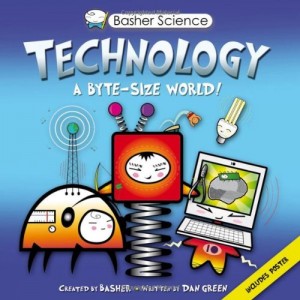 Technology: A Byte-Size World!
Technology: A Byte-Size World!
By Dan Green
Reading level: 10 and up
Paperback: 128 pages
Publisher: Kingfisher
What to expect: Age appropriate explanations of technological devices and how they function in our daily lives.
The Basher Science series aims to provide in-depth knowledge of scientific concepts through age appropriate language and character-driven illustrations. In Technology: A Byte-Size World! author Dan Green provides a handbook that outlines the progression from the wheel and axle to solar and nuclear power and most everything in-between. There are entries on the digital camera, the microchip, explosives and satellites, to name just a few.
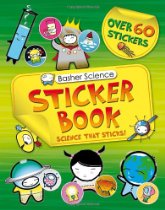 Basher Science Sticker Book: Science that Sticks!
Basher Science Sticker Book: Science that Sticks!
Created by Simon Basher
Reading level: 7-10
Paperback: 20 pages
Publisher: Kingfisher
What to expect: Sticker book that illustrates the solar system, ocean life, rocks and minerals, the weather and other complex scientific concepts.
The Basher Science Sticker Book: Science that Sticks! provides younger readers with a visual description of planets and other celestial bodies in the solar system; the different geological formations found on planet Earth; and different meteorological phenomena; among other topics. The sticker book can be used alone or as a companion to the other books in the Basher Science series.
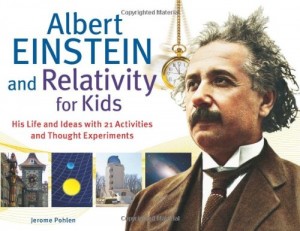 Albert Einstein and Relativity for Kids
Albert Einstein and Relativity for Kids
By Jerome Pohlen
Reading level: 9 and up
Paperback: 126 pages
Publisher: Chicago Review Press
What to expect: A chronicle of the life of Albert Einstein; scientific experiments and explanations.
In Albert Einstein and Relativity for Kids, we are introduced to Albert Einstein and given an inside glimpse of his life and the scientific experiments that led to his ground-breaking discoveries. The book includes 21 activities and thought experiments that allow young readers to explore Einstein’s ideas and test his conclusions. The book provides insight and knowledge for the curious young scientist. Makes a great starting point for further discussion and exploration.

